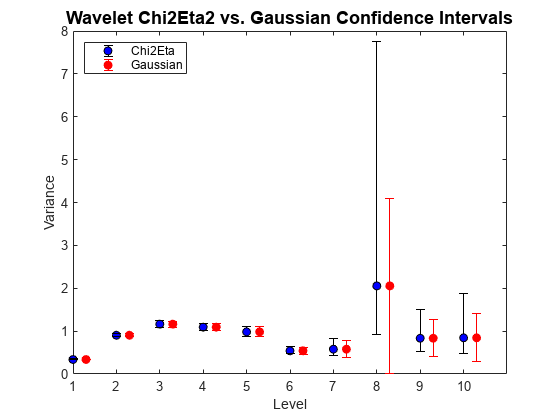modwtvar
Multiscale variance of maximal overlap discrete wavelet transform
Syntax
Description
[___] = modwtvar(
returns wavelet variance with additional options specified by one or more
w,wname,___,Name,Value)Name,Value pair arguments.
wvartable = modwtvar(w,wname,"table")"table" returns a MATLAB® table, wvartable, containing the number of
MODWT coefficients by level, the confidence boundaries, and the variance
estimates. You can place "table" anywhere after input
w, except after any Name,Value
argument.
modwtvar(___) with no output
arguments plots the wavelet variances by scale with lower and upper
confidence bounds. The scaling variance is not included in the plot
because the scaling variance can be much larger than the wavelet variances.
Examples
Input Arguments
Name-Value Arguments
Output Arguments
Algorithms
The following expressions define the variance and confidence methods used in the MODWTVAR. The variables are:
Nj — Number of coefficients at level j
v2 — Variance
j — Level
Wj,t — Wavelet coefficients
The variance estimate is
The degrees of freedom for the Chi2Eta1 (chi2eta1)
method are defined as
where
In this equation, is the spectral density function estimate of the wavelet coefficients at level j.
The chi-square statistic is
The degrees of freedom for the Chi2Eta3 (chi2eta3)
method are defined as
The chi-square statistic is
For the Gaussian method, the statistic
is distributed
as N(0,1). The variable is
as described for chi2eta1.
References
[1] Percival, Donald B., and Andrew T. Walden. Wavelet Methods for Time Series Analysis. Cambridge: Cambridge University Press, 2000.
[2] Percival, Donald B., and Debashis Mondal. “22 - A Wavelet Variance Primer.” In Time Series Analysis: Methods and Applications, edited by Tata Subba Rao, Suhasini Subba Rao, and C. Radhakrishna Rao, 1st ed., 623–57. Handbook of Statistics, v. 30. Amsterdam ; London: Elsevier, 2012. https://doi.org/10.1016/B978-0-444-53858-1.00022-3.
[3] Cornish, Charles R., Christopher S. Bretherton, and Donald B. Percival. “Maximal Overlap Wavelet Statistical Analysis With Application to Atmospheric Turbulence.” Boundary-Layer Meteorology 119, no. 2 (May 2006): 339–74. https://doi.org/10.1007/s10546-005-9011-y.
Extended Capabilities
Version History
Introduced in R2015b

